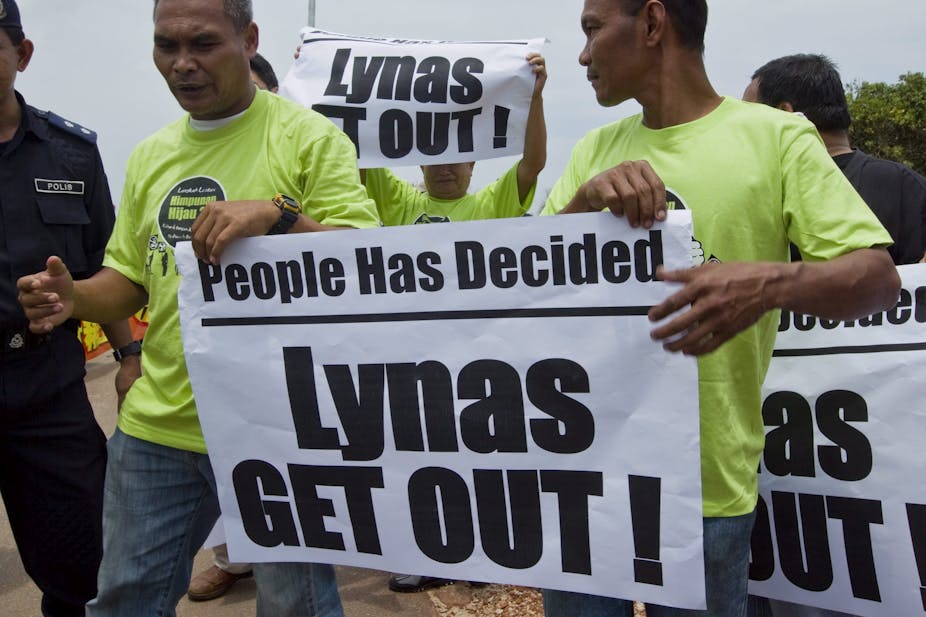The radioactive waste generated by an Australian-owned rare earth extraction factory in Malaysia has generated a firestorm of controversy. The factory - the world’s largest - is owned by Lynas Corporation, and will extract rare earths from materials shipped in from Western Australia.
The factory is at Gebeng, near the city of Kuantan in Malaysia. The population of the metropolitan area is about 700,000. The factory is located very near to the South China Sea.
At full capacity, it will be the world’s largest rare earth extraction plant: about 22,000 tonnes of rare earth elements per annum will be extracted from material shipped in all the way from Mount Weld, Western Australia.
The wastes from production will include radioactive thorium and uranium and their radioactive decay products such as radium and radon. The wastes will not be shipped back to Australia for safe disposal since Australian authorities have explicitly refused to accept them.
Lynas has been granted a temporary operating license (TOL) for two years, and a generous 12-year tax exemption. But the project lacks an International Atomic Energy Agency-recommended long-term waste management plan, and there is no “permanent disposal facility” (PDF) for the wastes.
Critics are alarmed by the fact that no Detailed Environmental Impact Assessment (DEIA) has been done, no long term waste management plan exists. Meanwhile, wastes are to be stored temporarily onsite.
Lee Bell of the National Toxics Network estimated (based on the experience of China) that 22,500 tonnes of radioactive waste (containing water) will be produced per annum. Non-radioactive wastes include:
- 191.25 tonnes of fluoride compounds
- 292.50 tonnes of flue dust particulates
- between 216 million cubic metres to 270 million cubic metres of waste gas (containing nitrous oxides, carbon monoxide, sulphur dioxide, hydrofluoric acid, dust concentrate and sulphuric acid)
- 1,687,500 cubic metres of acidic wastewater.

Lynas also plans to have liquid discharge of 500 tonnes per hour into the nearby Balok River which flows into the South China Sea. The site is on reclaimed swampy, peat land with a high water table. What’s more, it was actually flooded during the monsoon season of 2011-2012.
Lynas’ “Radioactive Waste Management Plan"¹ is as follows. Wastes generated are to be processed into synthetic gypsum for the manufacture of plaster board; gypsum for the manufacture of cement; magnesium-rich gypsum fertilizer for plantations, crops and for soil remediation; and carbon-enriched magnesium gypsum fertilizer to rejuvenate acidic soils.
Lynas alleges that any material remaining can either be "disposed safely in a secure municipal landfill” if classified as non-scheduled wastes or “disposed at a licensed facility” if classified as scheduled wastes by the Malaysian Department of the Environment.
Wastes are also to be commercialised as road building material, failing which it will be “permanently isolated” (whatever this means).
The public lacks confidence in the regulatory authorities because of experience with the earlier Asian Rare Earth (ARE) project in Bukit Merah, Malaysia. This was partly owned by Mitsubishi. Its aim was to extract the rare earth yttrium from monazite ore.
The ARE project operated from 1982 to 1994 in spite of strong protests from residents of Bukit Merah and nearby communities. It was closed by court order in 1992, but the verdict was suspended and eventually overturned by the Supreme Court in 1993. ARE finally closed due to public pressure (including pressure in Japan).
There were at least eight leukemia cases in five years among a population of only 11,000 people (five times higher than the expected incidence for Malaysia). The residents of Kuantan fear a repeat of the Bukit Merah experience (but on a much larger scale as the Lynas factory will be ten times the size).
The controversy is ongoing: the green light has been given to Lynas with the TOL issued by the Atomic Energy Licensing Board (AELB) of Malaysia.
So where does Australia stand in all this? Here’s what Norman Moore, the Western Australian Minister of Mines and Petroleum, said in response to the suggestion that the Lynas wastes be shipped back to Western Australia for safe storage and disposal:
Australia does not support the importation and storage of other countries’ radioactive waste.
In other words, the Australia-based Lynas Corporation’s wastes will not be an Australian problem. Instead, they will be a Malaysian and South China Sea regional problem.
Reference
- Lynas Corporation. Lynas-SHE-R-043Radioactive Waste Management Plan. rev 4. 2011

